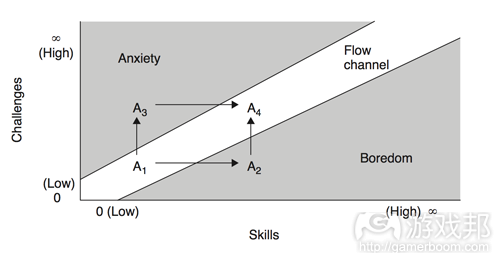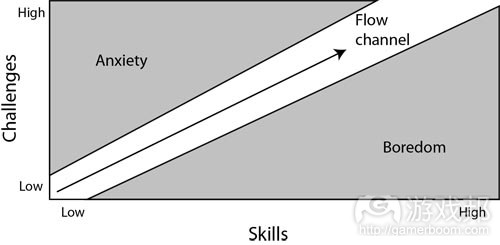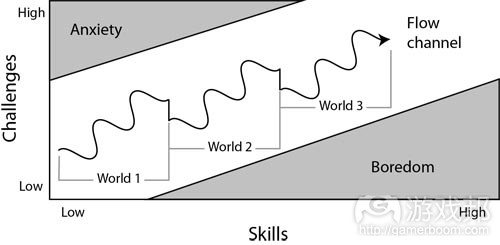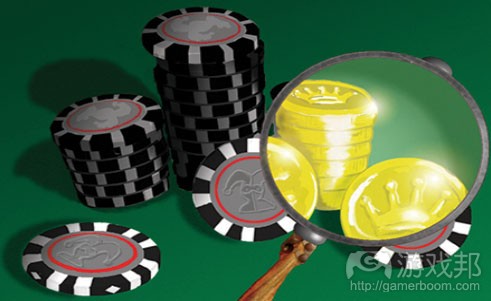|
作者:Toni Sala 我打算写一系列关于“游戏设计理论及其应用”的文章。游戏通常是靠灵感和直觉设计出来的。这不是什么坏办法,毕竟说到底,游戏设计是个非常讲究创造性的活动。 然而,有些已经被资深游戏设计师理论化的游戏设计思路,尽管听起来很明显,但在设计自己的游戏时仍然要牢记在心。我想从最有意义和最有效的一个游戏设计概念说起,它就 是流状态(Flow Channel)。《推箱子》运用这个概念产生了非常好的游戏体验。尽管通过玩大量游戏你也可以直觉地意识到这个概念,但我第一次看到它是在Jesse Schell的书 《The Art of Game Design》中。  flow-dual-ring-1(from gamasutra)
什么是流状态? 流状态是使我们专注于某个活动的心理状态。当我们失去流状态时,我们的注意力就会转移到其他活动上。所以显然,我们作为游戏设计师的目标是,让我们的玩家尽可能持久地 保持流状态。 这个概念适用于任何人类活动。导致流状态产生的因素各不相同,取决于具体的活动本身。对于游戏,我们要考虑五个因素:挑战vs.技能,焦虑vs.无聊,以及平衡这四个因素的 难度,或者叫作难度平衡。  流状态(from gamasutra)
从上图中可以看到所有相关的因素。A是指玩家的状态。理想的状态演变过程是从A1到A4.当处于A1状态时,我们的玩家刚开始玩游戏,还没有掌握游戏的技能。所以低级的挑战( 低挑战性)对他来说是合适的,因为此时他的技能水时也比较低。 如果游戏的挑战上升得太慢,玩家就会进入状态A2,也就是无聊期。这时,玩家觉得游戏没那么有意思了,打算放弃了。 另一方面,如果游戏的挑战上升得太快,玩家就会进入状态A3,也就是焦虑期。这时,玩家会觉得游戏太难了(尽管我们可能觉得他的技能水平太低,开玩笑的),仍然可能放弃 游戏。 注意:无论玩家觉得游戏太容易或太难,都是游戏设计师的错。玩家总是对的,因为他最懂自己喜欢什么不喜欢什么,他才是他自己的流状态的主人。作为游戏设计师,你的任务 是让尽可能多的玩家进入流状态。 焦虑和无聊都会让玩家感到失望,让玩家“失望”是游戏设计师听到的关于自己的游戏的最糟评价。你必须避免玩家对你的游戏失望,无论如何。失望会让玩家离开游戏,而且可 能永远也不再回来。 所以,我们的目标是让玩家尽可能留在下图所示的流状态阶段。  流状态线(from gamasutra)
然而,Jesse Schell在他的书中告诉我们,这是一个天真的设想。毫无疑问,在上图中,玩家总是留在流状态中。所以他提出另一个更理想的流状态模型:  流状态波(from gamasutra)
这种流状态更有意思得多。我们不仅让玩家留在流状态中,而且是给他们提供更好的游戏体验。在上图中,总体游戏难度始终是以合适的节奏上升的,且把玩家留在流状态中。然 而,游戏难度以固定的比率波动上升和下降,使玩家在游戏中既觉得舒适又感到满足。 举个例子更好理解:在像《光晕》这样的射击游戏中,一开始你只有很基础的武器,靠这些初级装备和基本的游戏技能就足已放倒你遇到的敌人。但随着游戏进展,你会得到使你 变得更强的新武器。根据Schell,这种幼稚的游戏设计方法,会马上提高敌人的实力,以便根据玩家的新状态提供新挑战。 然而,根据第三张图,我们暂时不应该增加敌人的力量。这样,玩家就能享受到短暂的“自己很强大,进步很快”的感觉。然而,这个短暂的时期过后,我们就要提供更多挑战, 以免玩家进入无聊期。 所以,在这种波动的挑战中,我们不仅把玩家留在流状态中,还奖励了玩家。如果对玩家来说,玩游戏本身就是一种奖励,那么他就会永远玩下去!这对游戏设计师来说就是最伟
大的胜利! 显然,没有说得那么容易。事实上,把玩家留在波动的流状态中是非常非常困难的。不过,我对《推箱子》试了一下,发现结果不太坏。 新的流状态 《推箱子》让我觉得骄傲的是它的谜题设计和总体难度平衡。我花了大量时间调整各个谜题的难度和平衡整体难度曲线。 另外,我还尝试使用本文所说的波动型流状态的概念。这款游戏的当前版本有50个谜题,平分到两个世界中(之后还会推出更多世界)。每个世界都会渐进地引入新的主要设定, 使玩家重新整理自己的技能和他目前为止所学到的机制。 显然,第一个谜题会比第二个容易。然而,第22个谜题并不一定比第23个容易。另一方面,当完成一个世界,玩家就会进入另一个,游戏的难度会增加一点点,因为他必须理解新 世界的规则。各个世界的25个谜题都使用这种模式。这是波动流状态的不规则版。如果我们进一入察看《推箱子》的波动型流状态,我们会看到下如下图所示的曲线:  flow-channel_fractal(from gamasutra)
所以,一定程度上,各个世界都采用波动型流状态。然而,从一个世界到另一个,在第2个到第4个谜题之间难度曲线会突然增加,这几个谜题是作为新世界的教程,当玩家掌握了 就马上提高难度。 这种“不规则流状态”非常适合《推箱子》。玩家很容易就理解和记住这种模式。所以,当谜题引入新机制时,下一个就会稍容易些,为了让掌握了新机制的玩家觉得自己变得更 强了。我还随机降低某些谜题的难度,这是为了让玩家觉得“这个谜题难住了,那就跳过去玩下一下,搞不好就过了。”这显然是一条潜意识的信息,玩家不一定会意识到,但管 用就行了。最后,这种“更容易的谜题”还让玩家的心态有所放松。在益智游戏中,心态休整是非常重要的,因为如果你觉得累,你可能就会离开游戏,失去对游戏“上瘾”的感 觉。 结论 正如你所见,流状态理论在我开发《推箱子》时发挥了重要的指导作用。当我在Schell的书中第一次读到它时,我觉得它是一个显而易见的概念,从这款游戏玩到另一款游戏的过 程中我一直在实践它。然而,为了把它正确地运用于游戏设计,你必须深入地研究和理解它。 所以,给你一条重要的提醒: 流状态的概念是非常强大的。无论你做什么游戏,都要使用它。 这是本系的第二篇文章。这次我想谈谈游戏中的奖励系统以及我如何在《推箱子》中运用。 游戏奖励系统是游戏设计中的一个非常重要的概念。事实上,玩家玩游戏一定程度上就是为了获得奖励。这是人类的本能需求。玩家需要合情合理的评价。这就是为什么哪怕是最 简单的游戏也必须谨慎地设计和平衡游戏的奖励系统。  rewards(from gamasutra)
一款游戏可以包含多种奖励形式,比如赞美的话、得分、延长游戏时间、道具奖励等,通常来说,游戏应该包含尽量多的奖励。然而,不要忘记游戏奖励必须保持平衡。你必须在 适当的时候给玩家适当数量的适当的奖励。 当设计《推箱子》时,我尝试加入不同类型的游戏奖励。然而,真正指导设计《推箱子》的奖励系统的过程的是我关注的两个更一般性问题: *奖励 vs. 惩罚 *休闲玩法 vs. 硬核玩法 *分层奖励系统设计 所以,我需要的奖励系统必须既能满足休闲玩家,又让硬核玩家满意,同时还要避免惩罚。为此,我设计了一个分层奖励系统。所谓的分层奖励系统就是,一开始玩家只能看到明 显的目标和得到明显的奖励(第一层),但玩了一段时间后,他开始发现游戏中还有更复杂的挑战和更吸引人的奖励。 我的意图是,不要让休闲玩家对那么多“不可能得到”的游戏奖励感到不知所措,同时给硬核玩家机会发现更具挑战性的隐藏层。事实上,对硬核玩家来说,发现隐藏层本身就是 一种奖励。 所以,一开始先用最基本的目标——解决谜题鼓励玩家。解决谜题就是第一层。通关的满足感、屏幕上的赞扬、得分和解锁后面的关卡就是这一层的奖励。 此时,第二层是什么就很明显了:如果你解决了谜题,但没有得到所有的三颗星,那么你就会看到奖励画面上的未填满的星星。另外,如果你再等一下,你会看到你挣到的所有额 外奖励和它们如何增加到你的最终得分中。这是对硬核玩家的奖励,因为他们总是想得到更高的分数。 这种额外奖励系统增加了更多层次。每一个玩家都会注意到自己所感兴趣的额外奖励。休闲玩家看完得到多少颗星星后就会直接跳过这个画面。硬核玩家会看完自己挣到的所有额 外奖励,然后想想自己是否可以提高分数。理解得分系统对硬核玩家来说,是一个有趣的挑战,能带来巨大的满足感。 所以,只有玩过几个谜题后,玩家才能根据他想得到的奖励树立自己的目标。休闲玩家把解决谜题当作目标,至于能得到几颗星星,并不重要。有些玩家力求每一个关卡都达到颗 星星。有些玩家想获得更高的得分。还有些玩家希望冲上排行榜第一名……其实理论上,所有玩家都可能经历这些阶段,这只是一个时间早晚的问题。 “隐藏”层 简单地说,休闲玩家只要求游戏有趣。大部分休闲玩家只要能解决谜题就满足了(游戏邦注:解决不了的谜题就跳过去)。所以,只要你的游戏够好玩,就能满足休闲玩家。 然而,硬核玩家的要求更高。显然,他们除了要求游戏有趣,还要求游戏具有挑战性。 所以,《推箱子》中有一些最有趣的“隐藏”层。 额外奖励系统 一开始,《推箱子》是纯惩罚性的。也就是说,如果你解决一个谜题花的时间太长,你就会受到惩罚。使用撤销选项?要受惩罚。重新开始游戏?要受惩罚。硬核玩家能忍受游戏 中存在一定程度的惩罚。事实上,惩罚在一定程度上增加了游戏的内在价值。然而,休闲玩家讨厌被游戏惩罚。所以,《推箱子》必须“正能量”一点,奖励玩家而不是惩罚玩家 。 积极平衡(奖励)的好处在于,没有人讨厌它。无论是休闲玩家还是硬核玩家,都喜欢奖励。有些类型的游戏必须把惩罚控制在最低程度。比如,那些算“命数”的游戏,在这类 游戏中,你失败一次就损失一条命。比如在《超级马里奥》中,蘑菇撞到你,你就损失一条命。然而,《推箱子》可以设计成完全不需要惩罚的样子。这也是我最终选择的方案。 于是诞生了额外奖励系统。所有惩罚都换成额外奖励。所以,当你完成一个谜题时,奖励页面会告诉你得到了什么额外奖励,比如时间延长、重玩/撤销一次,等等。所有额外奖励 都被换算成得分添加到你的最终分数中。额外奖励系统非常管用。 另外,这个额外奖励系统可能很容易被忽略,或者被部分忽略。你选择了你感兴趣的一种额外奖励,同时忘记了其他的。 高于标准系统 这个系统直到开发进入尾声才添加到游戏中。参加游戏测试的硬核玩家要求更复杂的挑战和更吸引人的奖励。所以“高于标准系统”应运而生。起初认为达到三星就表示用可能的 最佳方案解决了难题,然后发现自己居然用比标准的还少的步数就解决了谜题,这对硬核玩家来说是非常有成就感的。 此外,高于标准的解决方案会带来额外的奖励,并换算成得分计入最终得分中。 整体得分系统 一开始,得分是根据玩家解决谜题所走的步数计算出来的。后来,我增加了这个额外奖励系统。然而,我还需要一种细化玩家争取排行榜名次的方法。基于步数、星星或固定额外 奖励的系统给玩家表现作的评估结果是非常相似。 所以我增加了基于时间的额外奖励系统。游戏会记录玩家解开每一个谜题所用的时间。时间产生的额外奖励进入最终得分不是根据线性函数计算的,而是根据指数函数。这样,费 时多的玩家得到的额外得分往往接近,而费时少(几秒内就通关)的玩家得到额外分数的计算却精确到小数点第二位。所以,排行榜上的两名玩家几乎不可能得到完全相同的分数 。 这种精确度增加了排行榜的意义,使整体得分系统(游戏邦注:步数、星星和额外奖励)具有更大的评价维度。 Game Center 《推箱子》中的Game Center像一根把一切串起来的绳子。一切都是相关的:步数与星星有关;星星与得分有关;得分与额外奖励有关;额外奖励与成就有关;成就与排行榜有关; 排行榜又与得分有关。 这个紧密的循环非常有效。 结论 我认为,我花了那么多时间设计《推箱子》的分层奖励系统是值得的,因为这个高明的系统让几乎所有类型的玩家都对自己得到的奖励感到满足。 注意:具有复杂而平衡的奖励系统的简单游戏,有两个优势:它的简单能吸引休闲玩家,硬核玩家也能在游戏中得到挑战。 在之前的两篇文章中我们谈论了《New Sokoban》中有效的游戏设计元素。而今天我们将谈论一些应该更好地应用到《New Sokoban》的较复杂的内容,即游戏中的内在价值。  endogenous value(from gamasutra)
什么是内在价值? “endogenous(内在)这一词是源于希腊语ενδογεν??,即代表“从内部触发”(ενδο=内部,γεν??=来自)”——维基百科 “有关内在原因或起源”——Wordreference.com “从内部出发;由内部而来。”——Dictionary.com “拥有一个内因或起源。”——牛津英语词典 所以,游戏的内在价值是指源于游戏或游戏的某些部分中对于玩家有某种价值的目标是诞生于游戏内部并且只通过游戏设计手段获得。 为我们的游戏创造内在价值 所以,就像你所想的那样,为我们的游戏创造内在价值是非常有趣且有价值的。有趣的游戏固然很棒,但是带有内在价值的有趣游戏会更加出色。我们很难忘记一款带有内在价值 的游戏,如此便能更轻松地吸引玩家回到游戏中反复游戏从而创造出更多价值。即使这并不是游戏最有趣的点。 所以,依我看来,我们可以采取两种方法为游戏创造内在价值:非常困难的任务与内部经济。 你是否还记得玩一款很难完成的游戏?想象你在前进过程中失败了。多么戏剧化啊。通常情况下,那些很难获得的事物总是比简单的事物更有价值。 内部经济是获得内在价值的更强大工具。然而,在游戏中创造一个平衡的经济系统却是一项艰巨的任务。当说道“经济系统”时我并不是刻意涉及虚拟货币或贸易操作。像《星际 争霸》这样经典的RTS游戏便带有基于资源的经济系统,能够在内在价值角度上发挥有效作用。 不过我认为对于这种内在价值的最佳例子应该是MMO游戏,就像《魔兽世界。这类游戏通过设置了许多目标,任务和升级等等内容而为玩家创造了许多内在价值。 玩家一直在完成任务,杀死怪物和boss,甚至有时候这种行动还一点都不好玩!然而,奖励的价值却非常巨大,并且努力也是有价值的。 谨记:游戏中的内在价值与乐趣并没有关系。实际上,玩家是从难以获得的目标上察觉到内在价值,并且这些目标通常都不是很有趣。不幸的是,我们似乎不能察觉到乐趣的价值 。我猜这是一个游戏悖论。 强制性内在价值 强制性内在价值的结果便是不可能创造出任何内在价值,而只剩下一些常规价值。所有免费游戏都包含于这一类别中。作为设计师的你正在为游戏的目标和消费品定价。这并不是 源自内在。这只能算作常规价值。 所以我认为,将真钱带到谈论内在价值的等式中是没有意义的。 结论 不幸的是,《New Sokoban》是一款非常简单的游戏。我们很难将所有这些机制带入这样的小游戏中。我尝试着通过提高某些任务的难度而提升游戏的内在价值。完成所有的3星谜 题并不困难,但是找到游戏中所有低于标准杆的解决方法却非常困难。我希望做到这点的玩家能够认为他们的进程是有价值的。 拓展阅读:篇目1,篇目2,篇目3(本文由游戏邦编译,转载请注明来源,或咨询微信zhengjintiao) Game Design Theory Applied: The Flow Channel by Toni Sala I would like to start a series of articles about Theory of Game Design and how I applied (or tried to apply…) it to my projects. Usually games are made by inspiration and intuition. And this is not a bad approach because, at the end of the day, game creation is a deeply creative activity. However, there are some game design aspects that have been theorized by experienced game designers that, despite sounding quite obvious, it is worth to keep them in mind while working on our games. I would like to start by one of the most interesting and effective concepts of game design: The Flow Channel. Applying this concept to New Sokoban had a very positive impact on the games experience. Despite it being an intuitive aspect of games that you could have learned while playing a lot of games during your live, the first time I red about it was in Jesse Schell’s book The Art of Game Design. What’s the Flow Channel? The Flow Channel is the state of mind that makes us to stay focused on an activity. When we loose the flow, we switch to another activity. So obviously our aim as game designers is to keep our players in the flow channel for as long as possible. This concept applies to any human activity and the factors that make a person stay in the flow are different depending on the activity itself. For games, we are going to consider five factors: Challenges vs. Skills, Anxiety vs. Boredom and the one that balances them all: difficulty or difficulty balance. Flow Channel States (from “The Art of Game Design” book by Jesse Schell) On the above picture you can see all the factors in action. “A” is our player. The desired state evolution is from A1 to A4. When in A1, our player has no skills in our game because he has just started playing. So he feels comfortable with a low level of challenge (low game difficulty) because his skills are also low. If the challenges of the game rise too slow our player will switch to state A2, which is the Boredom realm. Here, the player feels that the game is not interesting an is likely to abandon it. On the other hand, if the challenges of the game rise too fast our player will switch to A3 state, which is the Anxiety zone. Here, our player will feel that the game is too difficult (despite we may think that his skills are too low… just kidding :p ) and is also likely to go for another activity. Mental note: if a player feels that your game is too easy or too difficult it is always your fault as game designer. Player is always right, because he is an expert about what he likes and he doesn’t and about his own flow channel. It is your task as game designer to fit the game into the flow channel of the maximum number of potential players. Both anxiety and boredom drives the player to frustration, and this is the worst word that a game designer can hear about his games. You need to avoid making the player to feel frustrated about your game, no matter what. Frustration makes the player leave the game and probably never coming back. So, our aim is to make the player stay on flow as showed in the picture below. Flow Channel Line (from “The Art of Game Design” book by Jesse Schell) However, Jesse Schell tells us in his book that this is the naive approach. No doubt that in the picture above the player is always in the flow. However, he suggests a better way of being in flow: Flow Channel Wave (from “The Art of Game Design” book by Jesse Schell) This is much more interesting. We are not only keeping the player in flow but also offering him a much better game experience. In this last picture, the overall game difficulty is always increasing at a right pace keeping the player in the flow. However, we are slightly decreasing and increasing of difficulty in a fixed rate that makes the player feel both comfortable and pleased with our game. It is better understood with an example: in a shooting game like Halo you start with a basic arsenal and the enemies you encounter are easy to defeat with your initial arsenal and your basic game skills. However, as you keep playing, you eventually will get a new weapon that will make you more powerful. The naive game design approach, according to Schell, would be to immediately increase the power of the enemies to offer new challenges according to the new state
of the player. However, according to the waved Flow Channel picture we should not increase the power of the enemies for a while. In doing so, the player will enjoy a short period of time feeling powerful and the feeling of progress will also be reinforced. However, after a while, we need to offer more challenges to the player to avoid him to enter the Boredom realm. So, with the waved Flow Channel we are keeping the player in flow and, in addition, we are rewarding him simply for playing. And if just playing our game is rewarding for the player, he will keep playing for the eternity! Epic win for the game designer! :p Obviously it is not that easy. Actually, keeping the player in a Waved Flow Channel is very very difficult. However, I have tried it for New Sokoban. And it was not that bad. New Sokoban Flow Channel If I’m proud of one thing about New Sokoban, it is the puzzle design and the overall difficulty balance. You can read a little bit more about this on this old post. I have spent tons of hours fixing the difficulty of each puzzle and balancing the overall difficulty curve. And I also tried to apply the Waved Flow Channel concepts described in this article. The current version of the game has 50 puzzles organized into two worlds (two more worlds are planned). Every world introduces a new main feature that makes the player rearrange all the skills and mechanics that he has learned so far. Obviously, the very first puzzle is much easier than the last one. However, for example, the puzzle number 22 is not necessary easier than the number 23. On the other hand, when a world is completed and the player moves to the next one, the difficulty is decreased a little bit because he needs to understand the new world rules. I repeat this pattern along the 25 puzzles of each world and also for the worlds. It is a kind of fractal pattern for the difficulty curve. If we zoom into the Waved Channel Flow for New Sokoban we would see something like the picture below: Fractal Flow Channel, extended from Waved Flow Channel So, in some sense, I follow the Waved Flow Channel in each world. However, from world to world the difficulty curve is suddenly decreased during 2-4 puzzles that serve as tutorial for the new world and then immediately increased when the player gets it. This kind of “Fractal Flow Channel” has worked very well for New Sokoban. The player easily catches and interiorizes it. So, when a puzzle introduces a new mechanic, the next one is slightly easier, just to make the player “feel the power” that the new mastered game mechanic has given to him. I also decrease the difficulty of a given puzzle arbitrarily, just to say to the player: “Hey! If you get stuck in a puzzle skip it. Maybe you will be able to solve the next one.” It is obviously a subliminal message, the player is not necessarily aware of that, but it just works fine. Finally, this kind of “easier-puzzles
” also make the players mind to take a rest. Mind resting in puzzle games is important because if you feel tired you will probably leave this game session and loose the feeling of being “addicted” to the game. Conclusion As you can see, the Flow Channel theory has been very important for me and for the development of New Sokoban. When I first red about it in Schell’s book I thought that it was an obvious concept that I had been practicing for my whole live while playing games from others. However, it is important to think deeply about it and understand it fully to be able to apply it correctly on your games. So, here you have a very useful mental note: Mental note: The Flow Channel concept is a very powerful one. Try to use it in all of your games. Today’s article is the second one in the series “Game Design Theory Applied”. You can find the first article of the series here. Today I would like to talk about game rewards, and how I applied them on New Sokoban. Game rewards are a very important concept in game design. Actually, in some sense, players play games to be rewarded. It is a human need. Players need to be evaluated favorably. That’s why a well designed ad balanced game rewards system is key in any game, even for the simplest one. There are lots of kinds of game rewards that could be included in a game: praise, points, prolonged play, spectacle, powers, resources, completion… In general, you should include as many rewards as you can. However, never forget that game rewards must be balanced. You need to give the right reward, at the right time and in the right amount. When designing New Sokoban I tried to include different types of game rewards. However, I focused on two more general issues that drove the design process of the rewards system of New Sokoban: Rewards vs. Punishment Casual Gameplay vs. Hardcore Gameplay A layered rewards system design So, my aim was to offer a game reward system that included rewards for both casual and hardcore players while avoiding punishment. To achieve that, I designed the game rewards system in layers. A layered rewards system design means that the player initially only sees the obvious objectives and gets the obvious rewards (the firsts layers) but after playing a while, he starts to discover that there are some more complicated challenges with more satisfying rewards. The idea is not to overwhelm casual players with tons of “impossible” game rewards to achieve but at the same time give the opportunity to hardcore players to discover the hidden layers with the more rewarding challenges. Actually, discovering the hidden layers is a reward itself for a hardcore player. So, the player starts by encountering the basic objective: solve the puzzle. Simply solve it. This is the first layer. The reward is the satisfaction of completion, the praise in the rewards screen, the score and the following puzzle that is unlocked. At this moment the following layer is presented clearly: if you solved the puzzle with less than 3 stars you will see unfilled stars on the rewards screen that claim to be filled. That’s layer two. Moreover, if you wait a moment, you will see all the bonuses you earned and how they add to your final score. That is rewarding for hardcore players as they always want higher scores.The bonuses system adds some more layers. Every player will pay attention to the bonuses he is interested on. Casual players will just skip this screen after seeing the number of stars achieved. Hardcore players will examine all the bonuses earned and wonder if they could improve their score based on the score system of the game. Understanding the score system is an interesting challenge for a hardcore player with a great satisfaction reward when it is achieved. So, only after playing a few puzzles every player has established his own objectives based on the game rewards he wants to achieve. Casual players will keep just solving puzzles. With 1 star, doesn’t matter. Some other players will go for the 3 stars for every puzzle. Others will try to maximize score, others will fight for the first row at Game Center leaderboards… Actually, theoretically, all the players may go throughout all theses phases eventually. Ones earlier than others. The “hidden” layers So, to say it short, the casual player “only” needs the game to be fun. Most casual players are satisfied simply solving some puzzles (and skipping others). So, you “only” need a good game to satisfy casual players. However, hardcore gamers need more. Obviously, they need a fun game but also a challenging one. Next, you have some of the most interesting “hidden” layers of New Sokoban. The bonus system Initially New Sokoban was pure punishment. You take too long to solve a puzzle, you get punished. Used the undo option? You get punished. Used the restart option? You get punished. Hardcore players tolerate certain level of punishment in games. Actually, punishment enhance endogenous value in some sense. However, casual players hate to be punished by games. So, New Sokoban needed to be “positivated”, rewarding players instead of punishing them. The advantage of positive balancing (rewarding) is that nobody hates it. Both casual and hardcore players love it. There are some types of games that need a minimum level of punishment to make sense. For example, games based on “lifes”. If you fall down you lose a life. If that mushroom touches you, you lose a life. However, New Sokoban is not that type of game. Actually, New Sokoban can be designed without any kind of punishment. And that was the way I finally followed. New Sokoban went from hell to heaven! And the bonus system was born. All punishing features were reconverted to bonus ones. So, when you complete a puzzle the rewarding screen informs you about all the bonuses you acquired: time bonus, no undo/restart bonus, etc. And all the bonuses are translated to points that are added to your final score. The bonus system worked really well. Moreover, the bonus system may be easily ignored. It can even be partially ignored. You decide which bonuses you are interested in and forget about the others. The under par system The under par system was added in the final stages of development. Hardcore testers were claiming for more complicated challenges with really satisfying rewards. And the under par system was created for that. Believing that 3 stars is the best possible solution and then discover that you solved one puzzle under par is very satisfying for a hardcore player. Moreover, under par solutions adds a great score bonus to the puzzle final score. The whole score system. Discovering how to get the best score possible Initially, the score was based on the moves the player needed to solve the puzzle. Then, I added the bonus system. However, I needed a way that players fighting for the first position on Game Center could differentiate from each other. A system based on moves, stars or fixed bonuses produced very similar scores from player to player. So I added the time bonus. Every puzzle records the time elapsed to solve it in tenths of a second. The final time bonus score is not calculated with a linear function. Instead of that I used and exponential one. That way, the time bonus score for long periods of time tends to be the same but you have tenths of a second precision for short periods of time (a few seconds). So, it’s almost impossible that two players get exactly the same score on Game Center. This kind of precision adds interest to the Game Center leaderboards and makes the whole score system (moves, stars and bonuses) take a bigger dimension. Game Center Game Center in New Sokoban is the rope that tie everything together. Everything is related: moves are related to stars. Stars are related to score. Score is related to bonuses. Bonuses are related to achievements. Achievements are also related to leader boards and leaderboards are related to score again. It’s a nice and elegant cycle that works really well. Conclusion I think that the time I spent designing the layered game rewards system of New Sokoban was worthwhile. The final result is elegant and almost every type of player feels comfortable with the rewards he receives. Mental note: a very simple game with a sophisticated and well balanced rewards systems offers the best of the two sides: simplicity for casual gamers and challenge for hardcore ones Today’s article is the third one in the series “Game Design Theory Applied”. You have the previous two here: Game Design Theory Applied: The Flow Channel Game Design Theory Applied: A Layered Rewards System In the previous two articles I talked about game design aspects that I think that were well addressed in New Sokoban. However, today I’m going to talk about a very difficult and tricky topic that should be better applied to New Sokoban: endogenous value in games. What’s endogenous value? “The word endogenous derives from the Greek: ενδογεν??, meaning “proceeding from within” (“ενδο”=inside “-γεν??”=coming from)” – Wikipedia“Relating to an internal cause or origin” – Wordreference.com “Proceeding from within; derived internally.” – Dictionary.com “Having an internal cause or origin.” – Oxford Dictionary of English So, endogenous value in games is achieved when some objects in the game or some part of the game have some kind of value to the player generated inside the game and only by game design means. Giving endogenous value to our games So, as you can imagine, giving endogenous value to our games is very interesting and desirable. Fun games are great, but fun games with endogenous value are better. It is more difficult to forget a game that has endogenous value, so it is easier for the player to come back and play again to increase that value. Even if it is not the funniest of the games. So, from my point of view, there are two ways of giving endogenous value to our games:very difficult tasks and internal economies. Do you remember playing a game that was extremely difficult to complete? Imagine that you lose your progress. That would be dramatic… In general, things that are hard to achieve have more value than easier ones. No fancy science here I guess. Internal economics are a more powerful mechanic to gain endogenous value. However, creating a well balanced economics system in a game is a titanic task. When saying “economics system” I don’t necessarily mean involving virtual money or trading operations. Classic RTS games like Starcraft have resources based economy systems that works great from the endogenous value point of view. However, I think that the best example for this kind of endogenous value are MMO games like World of Warcraft (no, I’m not working for Blizzard, but I like their games :p ). These kind of games generate an incredibly amount of endogenous value to players by having lots of objects, tasks, power-ups, etc, that have value in the game for players. Players complete quests, kill monsters and bosses all the time, even when it is not fun! However, the value of the reward is so huge that the effort is worthwhile. Mental note: endogenous value in games is not related with fun. Actually, in general, players perceive endogenous value from things that are hard to achieve and often not so fun to do. Unfortunately, it seems that we don’t perceive the value of fun. It’s a gaming paradox I guess. Or maybe a human one… Forcing endogenous value The result of forcing endogenous value is having no endogenous value at all but regularvalue. All FreeToPlay games are included to this category. You, as the designer, are pricing the objects and consumables of your game. That’s not endogenous. That’s just regular value. So from my point of view, when real money is introduced to the equation talking about endogenous value has no sense. Conclusion Unfortunately, New Sokoban is a very simple game. It is very difficult (at lest for me) to introduce all these mechanics to a little game like this one. I tried to increase the endogenous value of the game by means of increasing the difficulty of some tasks. Completing all the puzzles with 3 stars is not that difficult but finding all the under par solutions in the game is very, very difficult. I hope that players that achieve it consider their progress valuable.
|